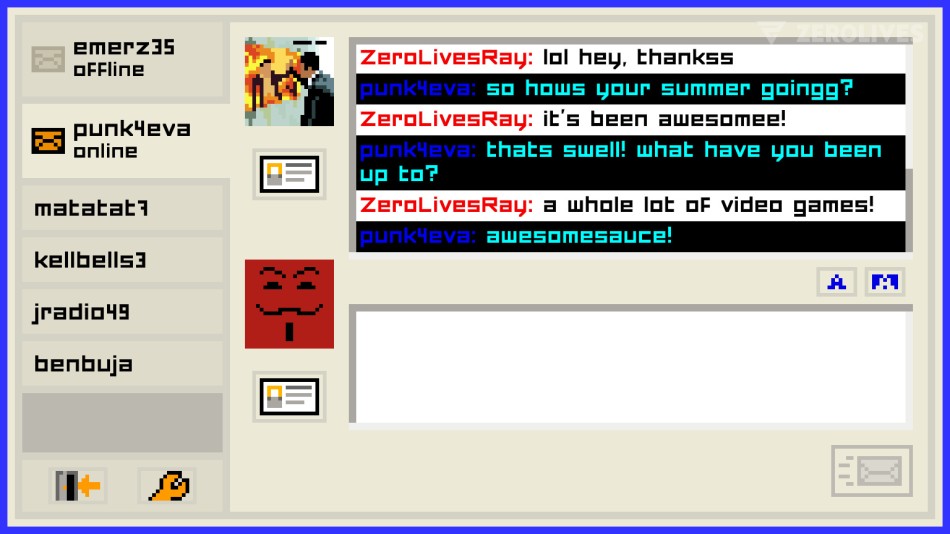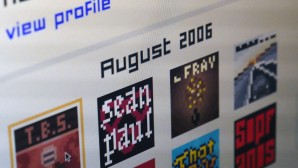Emily Is Away Too is the sequel to the popular text-based indie game Emily Is Away. The new game features a new, longer storyline and includes many new gameplay mechanics and references to be discovered that make the game incredibly fun to play.
The game is the spiritual successor to the original title, meaning that the game's storyline doesn't pick up where the original left off. The game starts in the summer of 2005 and ends in the summer of 2007.
This time around, players play as a teenager who chats with two characters, Emily and Evelyn and, just like the first game, the conversation progresses by selecting from a variety of responses that could influence the story as you continue playing.
The new game features drastic changes to the user interface as the desktop login sequence that was available in the first game has been completely scrapped. The game is now also played through a window, while the first game was a fullscreen experience.
This turned out to be a great change because it allows for several new gameplay mechanics to be introduced, such as links to websites, file transfers and even interactivity with the player's desktop.
While this is a scary thought at first, as software manipulating your desktop is considered unwanted these days, the game is actually able to use this feature to enhances the gameplay experience.
As you chat with the two characters they will send you links to songs, videos and memes, but also images and even chat logs that will end up as real files on your desktop.
The ability to receive links to songs on YouTube, however, is by far the best new gameplay mechanic and is nothing short of pure genius, because this allows the game to use nostalgic songs without having to pay royalties or acquire licenses.
The selection of songs used in the game is what makes this feature stand out the most, because characters will discuss songs that were popular between 2005 and 2007 from bands such as Coldplay, The Killers, The Strokes and Arctic Monkeys.
What makes this a well-rounded experience is that links don't actually point towards the current version of a specific website, but rather to a recreated pixel art version of it that features webdesigns that are very similar to the webdesigns that were used in 2005.
References to popular games, movies, bands and even clothing aren't just available via links, however, because they are also incorporated in the many pixel art buddy icons that are available for players to choose from and in the fake advertisements that appear on the chapter selection screen.
There are even user bio's and fake Facebook profiles that include many of these references, and profiles can sometimes be used to check out the preferences of the characters you're talking to, which in turn can help you progress through the game in the way you want.
Players are also given the opportunity to create their own in-game user bio by selecting from a variety of options per chapter, but these options rarely seemed to have an impact on the way the story plays out.
Aside from chatting with the two characters, the game also awards players with unlocks for secret buddy icons that, when selected, unlock a new character to talk to.
A noteworthy example is the inclusion of a parody version of Overwatch game director Jeff Kaplan, with whom you discuss how the game's revenue stream is mostly based on lootbox gambling.
My biggest gripe with the second game is that only certain steps in the game's storyline have branching-off points, meaning that the many answers you select between these junctions make no difference further down the line.
This means that after two or three playthroughs you will be able to predict what characters will say and how they will react to your answers.
While this is totally fine in theory, because it allows players to more easily figure out different endings, the reality of it is that it makes the game a lot less entertaining and engaging to play for extended periods of time.
This becomes even more noticeable when you see that some parts of dialog are essentially swapped between the two characters depending on the answers you give to one of them. In essence this means that both characters can share the exact same parts of dialog without it matching their personality at all. This is a missed opportunity.
Another issue I have with the game is that in chapter three there is a specific timer event in which players are essentially forced to choose to talk to one of the two characters, and this decision influences the relationship between you and the character as you continue playing.
While this mechanic isn't necessarily bad, it does mean that the character that you choose not to talk to is not talking to you again until the very last chapter of the game.
Unlike the first game, this second game does have endings in which the player will end up in a relationship with one of the two characters.
Although many players praised the original for not having an ending where you get together with the character, this was an important change to make because this allowed multiple endings to be implemented.
Once the story has ended the game shows a statistics screen that lists the percentages of how many players got the same ending as you, how many players talked to same character and how many players were more than friends with the character.
Figuring out the different endings can be considered an end game goal. However, there will also be players that would much rather spend time unlocking the secret buddy icons for additional entertainment, which can also be unlocked by using codes that are shared on the game's Steam community hub page.
Overall
Rating this type of simulation RPG game is incredibly though, especially considering there is nothing quite like this on the market to compare it to, except for the original game that was released for free in 2015.
When you compare the two, this second game can be considered an even better tribute to the early days of the internet.
The game includes even more references to internet culture that made the first game popular, and combined with the new storyline and recreations of popular websites from back in the day, the $4.99 price tag is certainly justified.
That being said, the game targets a very specific niece audience, so the genre of the game certainly isn't for everybody and that is definitely something to keep in mind if you are considering purchasing the game.
Those who pick this title up are in for an entertaining journey back in time. The new mechanics are a fun addition to original gameplay, though a single playthrough still felt a little too short, despite the game's larger storyline and multiple endings. That is why we give the game an 8 out of 10.















Comments